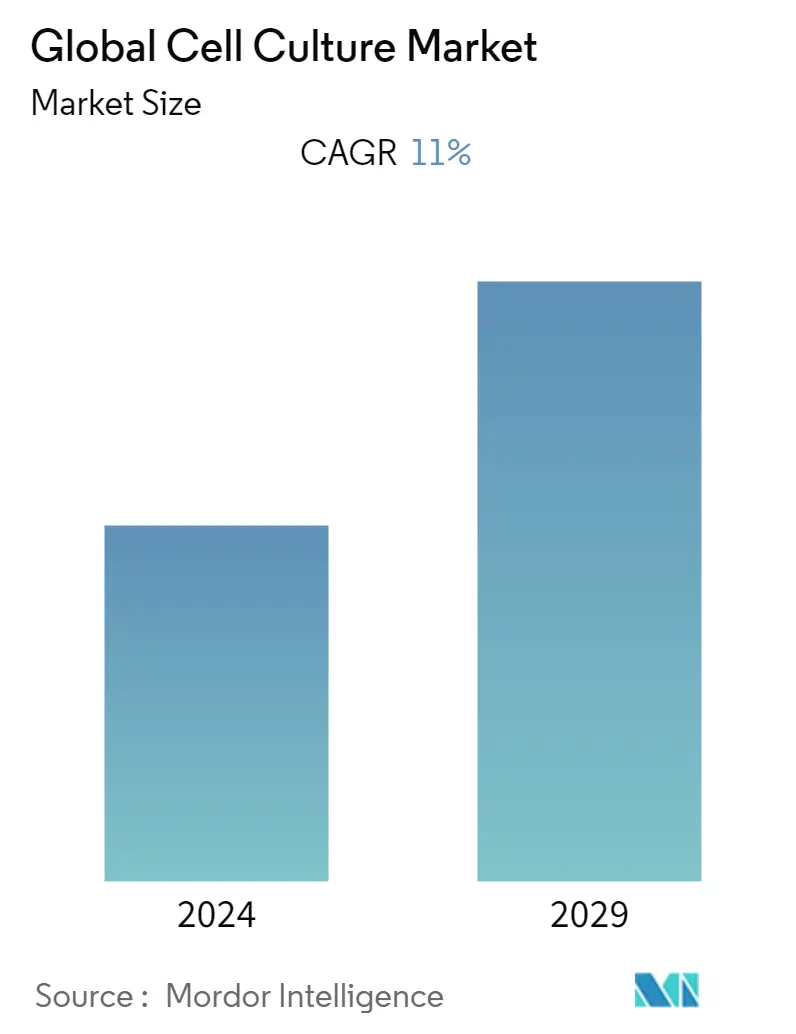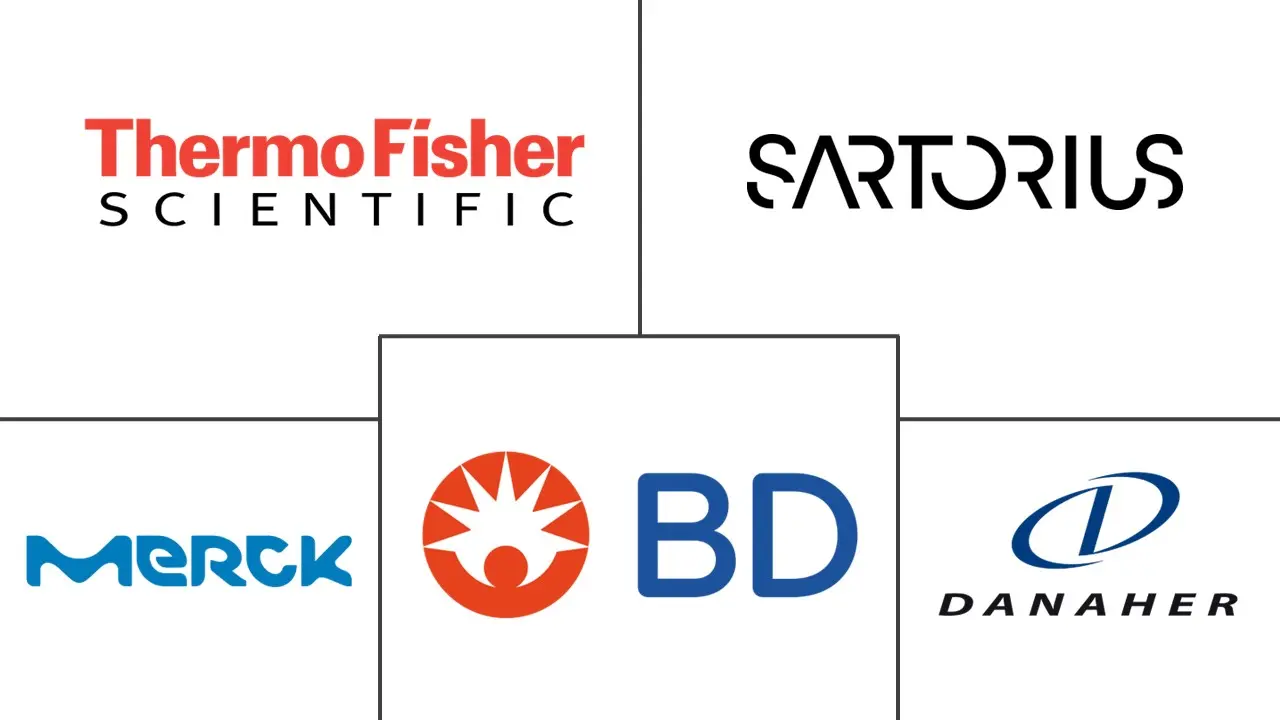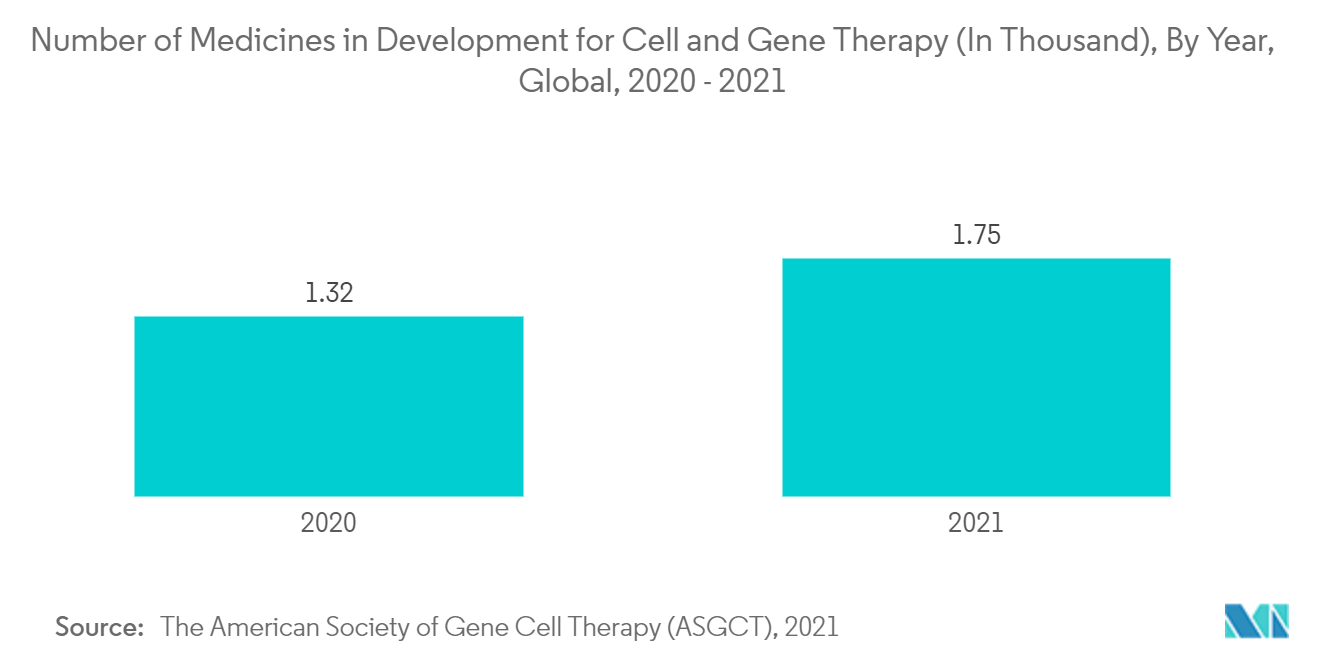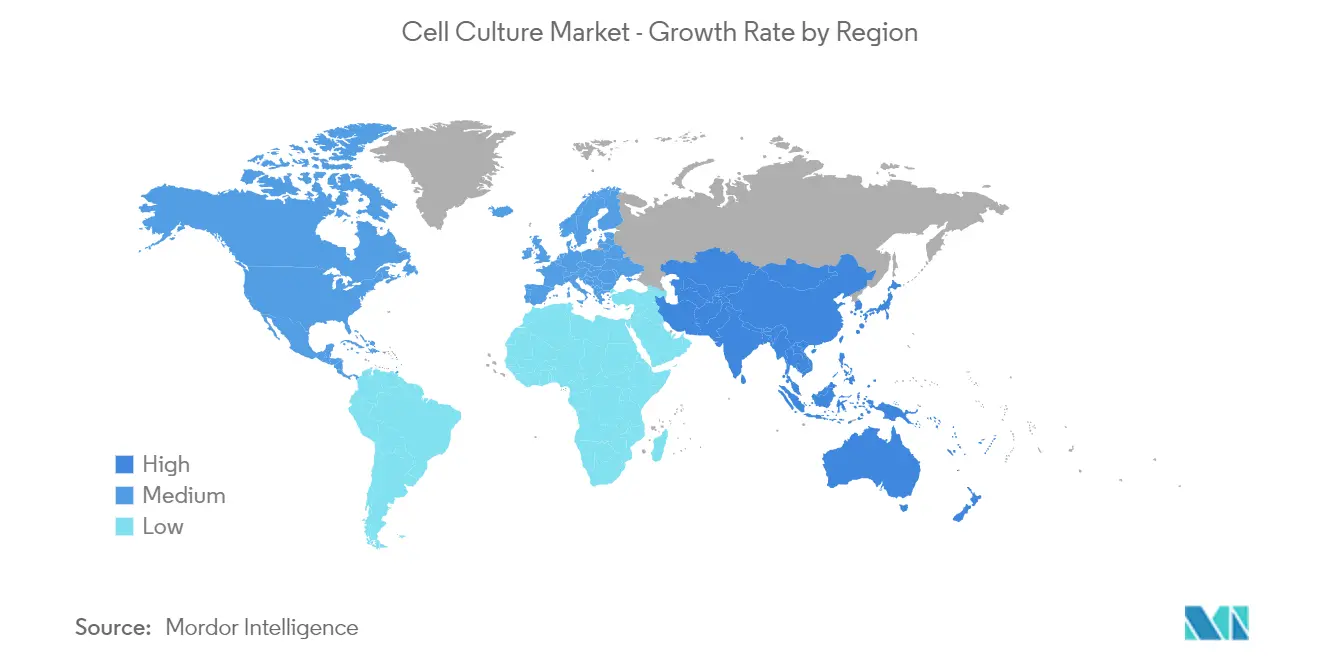Cell Culture Market Size

| Study Period | 2019 - 2029 |
| Base Year For Estimation | 2023 |
| Forecast Data Period | 2024 - 2029 |
| CAGR | 11.00 % |
| Fastest Growing Market | Asia Pacific |
| Largest Market | North America |
Major Players
*Disclaimer: Major Players sorted in no particular order |
Cell Culture Market Analysis
The cell culture market is expected to witness a CAGR of 11.0% over the forecast period (2022-2027).
With the onset of COVID-19, many biotech and pharmaceutical firms, government organizations in various countries, and research institutes started to focus on the development of effective vaccines and new therapeutics to overcome the situation. Cell culture may serve as a potential platform for the development of novel vaccines for the treatment of COVID-19. Additionally, initiatives taken by the market players in such directions also led to a significant impact on the market's growth. For instance, in January 2021, Captivate Bio launched its portfolio of cell culture tools to assist in the fight against COVID-19 and other emerging diseases in the United States. Thus, COVID-19 had a pronounced impact on the growth of the market.
The major factors such as the growing demand for personalized medicine coupled with the rise in the demand for vaccines, biopharmaceuticals, and artificial organs coupled with the advancement in technology and the launch of products and consumables are driving the growth of the market over the forecast period.
According to GLOBOCAN Statistics, there were an estimated 19.3 million new cases of cancer around the world in the year 2020, and it is projected to reach 30.2 million by 2040. Such an increasing burden of cancer creates the need for precision medicine, so the demand for cell culture is expected to increase over the coming years as cell culture plays a vital role in the development of personalized medicine. Additionally, increasing research and development in pharmaceuticals and biopharmaceuticals also contributes largely to the growth of the market. For instance, according to the European Federation of Pharmaceutical Industries and Associations, 2022 report, the pharmaceutical industry in Europe incurred expenses of EUR 39,656 million for its research and development, and for 2022, this expense is expected to be EUR 41,500 million. Such an increasing focus on research and development creates the need for cell cultures for testing the effectiveness of the drug and thus drives the growth of the market.
The launch of products is also expected to drive the growth of the market. For instance, in March 2021, Thermo Fisher Scientific launched its new Gibco Human Plasma-like Medium (HPLM). It is one of the first types of cell culture medium that mimics the metabolic profile of human plasma and is designed to provide researchers with a realistic view of cell growth within the human body.
Additionally, the launch of technologically advanced and innovative products also propels the growth of the market. For instance, in February 2022, Nucleus Biologics launched Krakatoa. It is an innovative, one of the first to market media makers that helps researchers to manufacture cell culture media at the point of use.
Thus, owing to the abovementioned factors, the cell culture market is expected to show considerable growth over the forecast period. However, the high cost associated with cell-based research and the lack of infrastructure for cell-based research in emerging economies may impede the growth of the market.
Cell Culture Market Trends
This section covers the major market trends shaping the Cell Culture Market according to our research experts:
Drug Development Segment is Expected to Witness Rapid Growth Over the Forecast Period.
Cell culture is an integral part of medical research and drug discovery. Drug development is a time-consuming and costly procedure that is completed in multiple stages, from target identification to lead discovery and optimization, preclinical validation, and clinical trials, culminating in approval for clinical use. Cell-based high throughput screening (HTS) is currently being carried out on cultured cells propagated in two dimensions (2D) on plastic surfaces optimized for tissue culture. With the emergence of 3D cell culture, the process of HTS has become easier and more accurate.
Furthermore, the support from the governments of different countries for drug discovery is also contributing to the growth of the segment. For instance, in July 2020, the Union Government of India launched the Drug Discovery Hackathon "Nishank". This Hackathon is a first-of-its-kind national initiative for supporting the drug discovery process and is supported by various departments as well as market players.
Additionally, the initiatives taken by the market players are also expected to boost the growth of the market segment. For instance, in November 2021, Merck signed a Memorandum of Understanding (MoU) with GI Innovation, to facilitate biomedicine development in Korea. As per the MoU, Merck provides technologies and services, including the CHOZN platform, cell culture media, and downstream process development, to promote research and development of critical life-saving cancer treatments, as well as drugs for allergy-related conditions. Such initiatives also contribute to the growth of the segment.
Thus, owing to the abovementioned factors, the market segment is expected to project significant growth over the forecast period.

North America Dominates the Global Cell Culture Market Over the Forecast Period
North America is currently dominating the cell culture market and is expected to follow the same trend over the forecast period. This is majorly attributed to the growing demand for personalized medicine coupled with the rise in the demand for vaccines, biopharmaceuticals, and artificial organs, and the presence of key players in the market.
According to the American Cancer Society's 2022 statistics, there will be an estimated 1,918,030 new cases of cancer in the United States in 2022. Such an increasing burden of diseases such as cancer creates the need for precision medicine, which leads to the increase in demand for cell culture products and consumables for their development and hence drives the growth of the market.
The launch of products by the market players is also expected to drive the growth of the market. For instance, in December 2020, eNuvio Canada launched one of the first completely reusable 3D cell culture microplates, namely the EB-Plate. Such launches are expected to propel the growth of the market in the region. Additionally, in February 2022, KromaTiD launched a comprehensive suite of cell and blood culture growth, isolation, processing, and quality control services. The launch of such products and services by the companies also boosts the demand for cell culture products and consumables and is thus expected to drive the growth of the market.
Thus, owing to the abovementioned factors, the studied market in the North American region is expected to show considerable growth over the forecast period.

Cell Culture Industry Overview
The cell culture market is moderately competitive and consists of several major players. In terms of market share, a few of the major players currently dominate the market. The presence of major market players, such as Thermo Fisher Scientific, Danaher Corporation, Sartorius AG, Merck KGaA, and others, also increases the overall competitive rivalry of the market. Additionally, the product advancements and improvements in cell culture platforms by the major players are also increasing the competition.
Cell Culture Market Leaders
-
Thermo Fisher Scientific
-
Danaher Corporation
-
Sartorius AG
-
Merck KGaA
-
Becton, Dickson and Company
*Disclaimer: Major Players sorted in no particular order

Cell Culture Market News
- In June 2022, Evonik launched the cQrex portfolio of cell culture ingredients to increase efficiency and productivity in bioprocesses for producing monoclonal antibodies, vaccines, viral vectors, and therapeutic cells.
- In February 2022, CellulaREvolution raised GBP 1.75 million to accelerate the launch of its continuous cell culture technology.
Cell Culture Market Report - Table of Contents
1. INTRODUCTION
1.1 Study Assumptions and Market Definition
1.2 Scope of the Study
2. RESEARCH METHODOLOGY
3. EXECUTIVE SUMMARY
4. MARKET DYNAMICS
4.1 Market Overview
4.2 Market Drivers
4.2.1 Rise in the Demand for Vaccines, Biopharmaceuticals and Artificial Organs
4.2.2 Growing Focus on Personalized Medicine
4.3 Market Restraints
4.3.1 High Cost Associated with Cell Based Research
4.3.2 Lack of Infrastructure for Cell-based Research in Emerging Economies
4.4 Industry Attractiveness - Porter's Five Forces Analysis
4.4.1 Bargaining Power of Buyers/Consumers
4.4.2 Bargaining Power of Suppliers
4.4.3 Threat of New Entrants
4.4.4 Threat of Substitute Products
4.4.5 Intensity of Competitive Rivalry
5. MARKET SEGMENTATION (Market Size by Value - USD million)
5.1 By Product and Consumables
5.1.1 Product
5.1.1.1 Biosafety Equipment
5.1.1.2 Centrifuges
5.1.1.3 Cryostorage Equipment
5.1.1.4 Culture Systems/Bioreactors
5.1.1.5 Incubators
5.1.1.6 Pipetting Instruments
5.1.1.7 Others
5.1.2 Consumables
5.1.2.1 Media
5.1.2.2 Sera
5.1.2.3 Reagents
5.2 By Application
5.2.1 Biopharmaceuticals
5.2.2 Drug Development
5.2.3 Gene Therapy
5.2.4 Tissue Culture and Engineering
5.2.5 Vaccine Production
5.2.6 Other Applications
5.3 Geography
5.3.1 North America
5.3.1.1 United States
5.3.1.2 Canada
5.3.1.3 Mexico
5.3.2 Europe
5.3.2.1 Germany
5.3.2.2 United Kingdom
5.3.2.3 France
5.3.2.4 Italy
5.3.2.5 Spain
5.3.2.6 Rest of Europe
5.3.3 Asia-Pacific
5.3.3.1 China
5.3.3.2 Japan
5.3.3.3 India
5.3.3.4 Australia
5.3.3.5 South Korea
5.3.3.6 Rest of Asia-Pacific
5.3.4 Middle East and Africa
5.3.4.1 GCC
5.3.4.2 South Africa
5.3.4.3 Rest of Middle East and Africa
5.3.5 South America
5.3.5.1 Brazil
5.3.5.2 Argentina
5.3.5.3 Rest of South America
6. COMPETITIVE LANDSCAPE
6.1 Company Profiles
6.1.1 Biospherix
6.1.2 Hi-Media Laboratories
6.1.3 Merck KGaA
6.1.4 Promocell GmbH
6.1.5 Sartorius AG
6.1.6 Thermo Fisher Scientific
6.1.7 Danaher Corporation
6.1.8 Sekisui XenoTech LLC
6.1.9 Lonza Group
6.1.10 Agilent Technologies Inc.
6.1.11 Becton, Dickinson and Company
6.1.12 Cytiva
6.1.13 Corning Incorporated
- *List Not Exhaustive
7. MARKET OPPORTUNITIES AND FUTURE TRENDS
Cell Culture Industry Segmentation
As per the scope of the report, cell culture is the process of growing the cell under certain controlled conditions outside its natural environment. Once the cells of interest have been isolated from living tissue, they can subsequently be maintained under carefully controlled conditions. The Cell Culture Market is Segmented by Products and Consumables (Products (Biosafety Equipment, Centrifuges, Cryostorage Equipment, Culture Systems/Bioreactors, Incubators, Pipetting Instruments and Others) and Consumables (Media, Sera, and Reagents)), Application (Biopharmaceuticals, Drug Development, Gene Therapy, Tissue Culture and Engineering, Vaccine Production, and Others), and Geography (North America, Europe, Asia-Pacific, Middle East and Africa, and South America). The market report also covers the estimated market sizes and trends for 17 different countries across major regions, globally. The report offers the value (in USD million) for the above segments.
| By Product and Consumables | |||||||||
| |||||||||
|
| By Application | |
| Biopharmaceuticals | |
| Drug Development | |
| Gene Therapy | |
| Tissue Culture and Engineering | |
| Vaccine Production | |
| Other Applications |
| Geography | ||||||||
| ||||||||
| ||||||||
| ||||||||
| ||||||||
|
Cell Culture Market Research FAQs
What is the current Global Cell Culture Market size?
The Global Cell Culture Market is projected to register a CAGR of 11% during the forecast period (2024-2029)
Who are the key players in Global Cell Culture Market?
Thermo Fisher Scientific, Danaher Corporation, Sartorius AG, Merck KGaA and Becton, Dickson and Company are the major companies operating in the Global Cell Culture Market.
Which is the fastest growing region in Global Cell Culture Market?
Asia Pacific is estimated to grow at the highest CAGR over the forecast period (2024-2029).
Which region has the biggest share in Global Cell Culture Market?
In 2024, the North America accounts for the largest market share in Global Cell Culture Market.
What years does this Global Cell Culture Market cover?
The report covers the Global Cell Culture Market historical market size for years: 2019, 2020, 2021, 2022 and 2023. The report also forecasts the Global Cell Culture Market size for years: 2024, 2025, 2026, 2027, 2028 and 2029.
What are the growth opportunities in the Global Cell Culture Market?
The growth opportunities in the Global Cell Culture Market are a) Growing adoption in personalized medicine and cell therapy b) Increasing focus on automation and high-throughput screening
Cell Culture Industry Report
The global cell culture market, led by significant advancements in biotechnology and an increasing demand for novel therapeutics, is witnessing remarkable growth. This surge is fueled by the rising prevalence of chronic diseases and a keen focus on cell-based research, including a shift towards single-use technologies and personalized medicine. The market, offering lucrative opportunities in emerging economies due to flourishing biopharmaceutical sectors and government support, faces challenges like the high cost of cell biology research. Dominated by biopharmaceutical production, diagnostics, and tissue engineering applications, with pharmaceutical and biotechnology companies as the primary end users, the market benefits from the escalating demand for biopharmaceuticals and scalable production methods. North America stands as the largest regional market, thanks to substantial R&D expenditure and the presence of established industry players. The competitive landscape sees cell culture companies striving to expand their product portfolios and enhance market presence through strategic initiatives. According to Mordor Intelligence™ Industry Reports, the cell culture market is poised for continued growth, with detailed statistics on market share, size, revenue growth rate, and a forecast outlook available in a free report PDF download, offering promising prospects for stakeholders and cell culture companies.



